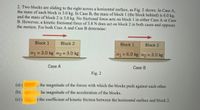Question

Transcribed Image Text:2. Two blocks are sliding to the right across a horizontal surface, as Fig. 2 shows. In Case A,
the mass of each block is 3.0 kg. In Case B, the mass of block 1 (the block behind) is 6.0 kg,
and the mass of block 2 is 3.0 kg. No frictional force acts on block1 in either Case A or Case
B. However, a kinetic frictional force of 5.8 N does act on block 2 in both cases and opposes
the motion. For both Case A and Case B determine:
Block 1
Block 2
Block 1
Block 2
m1 = 3.0 kg m2 = 3.0 kg
m1 = 6.0 kg m2 = 3.0 kg
Case A
Case B
Fig. 2
(a) (
the magnitude of the forces with which the blocks push against each other.
(b)
he magnitude of the acceleration of the blocks.
(c) (
) the coefficient of kinetic friction between the horizontal surface and block 2.
Expert Solution
This question has been solved!
Explore an expertly crafted, step-by-step solution for a thorough understanding of key concepts.
This is a popular solution
Trending nowThis is a popular solution!
Step by stepSolved in 4 steps with 1 images

Knowledge Booster
Similar questions
- A force F=100 N is exerted on m2 which has a mass of 10 kg. Block 1 has a mass (m1) of 40 kg. There is no friction between block 1 and the floor. If the static coefficient of friction between block 1 and 2 is 0.60 and the kinetic coefficient of friction between block 1 and 2 is 0.40, determine... (use g = 9.8 N/kg) a. The magnitude of the acceleration of block 1. b. The magnitude of the acceleration of block 2.arrow_forward2. Block A has a mass of 6.00 kg. Block B has a mass of 5.00 kg. The coefficients of friction between two blocks are us= 0.400 and uk = 0.200. The coefficients of friction between the blocks and the ramp are us=0.500 and μ = 0.300. The ramp is angled at 15.0° above the horizontal. 4 B The man pulls the blocks up the incline. What is the largest force he can pull with if he doesn't want the top block to slip?arrow_forwardDetermine the force Q-> when the block moves with constant velocity. Express your answer in vector form.arrow_forward
- 2. The block of mass m, in the figure has been adjusted so that the block of mass m, is on the verge of sliding. (a) If m1 = 7 kg and m2 = 5 kg , what is the coefficient of static friction between the table and the block? (b) With a slight nudge, the blocks move with acceleration of magnitude a. Find a if the coefficient of kinetic friction between the table and the block is µ = 0.54 m2arrow_forwardA stack of two crates is being accelerated upwards by two cables. The cables are directly attached to crate 1 and the tension in each cable is 3248 N. You may assume that the masses of the cables are negligible compared to the masses of the crates. The acceleration of the crates is? bottom crate crate 1 is 109 kg. the top crate is 248 kg.arrow_forwardA constant net force causes an acceleration of 20 m/s². What will be the acceleration of the object if the force is halved? Enter to 2 significant figures m/s² a = A constant net force causes an acceleration of 20 m/s². What will be the acceleration of the object if the mass is doubled? Enter to 2 significant figures m/s² a =arrow_forward
- The hanging sphere off the table has a mass of 2.51 kg. The string makes a 32.9° angle to the ceiling. How much does the sphere weigh? Find T1 Find T2 The block on the table does not move. How much friction must be acting between the table and the block?arrow_forwardBlock 1 (10 kg) is pulled by a rope from left to right up a ramp which is inclined 50 degrees from the horizontal. The rope pulls on block 1 with a force of 150 N parallel to the surface of the inclined plane. The coefficient of kinetic friction between the block and the surface equals 0.3. Weight force on block 1 by EarthW1E = Tension force on block 1 by RopeT1R = Normal force on block 1 by SurfaceN1S = Frictional force on block 1 by Surfacef1S = What is the acceleration a of block 1?a =arrow_forwardThe two forces F₁ and F₂ shown in the figure (Figure 1) (looking down) act on a 16.0-kg object on a frictionless tabletop. igure 90° F₂ y F₂ 120° (b) 1 of 1 Part A If F₁-12.0 N and F2-21.0 N, find the magnitude of the net force on the object for (a). F = Submit Part B 0 = Find the direction of the net force on the object for (a). Submit Part C 15. ΑΣΦ Request Answer Submit VE ΑΣΦ Request Answer Find the magnitude of the acceleration of the object for (a). 135) ΑΣΦ Request Answer Pearson ? N O from the + axis m/s²arrow_forward
arrow_back_ios
arrow_forward_ios